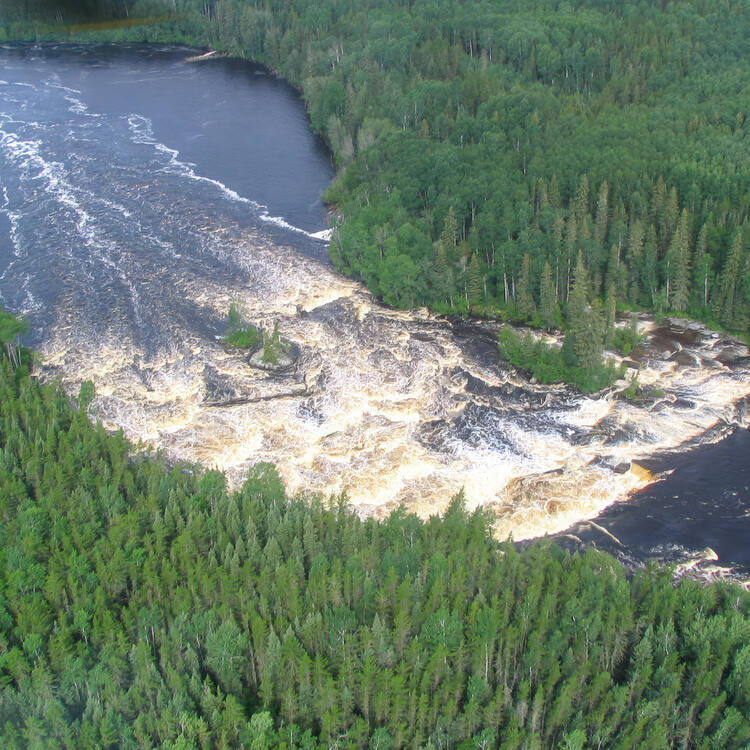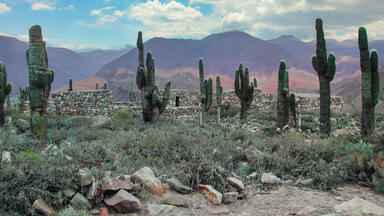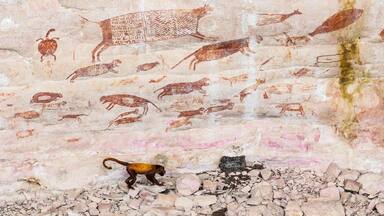Pimachiowin Aki
Pimachiowin Aki
Pimachiowin Aki ('The Land That Gives Life') is a landscape of rivers, lakes, wetlands, and boreal forest. It forms part of the ancestral home of the Anishinaabeg, an indigenous people living from fishing, hunting and gathering. The site encompasses the traditional lands of four Anishinaabeg communities (Bloodvein River, Little Grand Rapids, Pauingassi and Poplar River). It is an exceptional example of the cultural tradition of Ji-ganawendamang Gidakiiminaan ('keeping the land'), which consists of honouring the gifts of the Creator, respecting all forms of life, and maintaining harmonious relations with others. A complex network of livelihood sites, habitation sites, travel routes and ceremonial sites, often linked by waterways, provides testimony to this ancient and continuing tradition.
La description est disponible sous licence CC-BY-SA IGO 3.0
Pimachiowin Aki
Paysage forestier de rivières, émaillé de lacs, de zones humides et de forêts boréales, Pimachiowin Aki (« La terre qui donne la vie ») fait partie des territoires ancestraux des Anishinaabeg, un peuple autochtone vivant de la pêche, de la chasse et de la cueillette. Il englobe des portions de territoires de quatre communautés Anishinaabeg (Bloodvein River, Little Grand Rapids, Pauingassi et Poplar River). Il s'agit d'un exemple exceptionnel de la tradition culturelle Ji-ganawendamang Gidakiiminaan (« garder la terre ») qui consiste à honorer les dons du Créateur, respecter toute forme de vie et maintenir des relations harmonieuses avec autrui. Un réseau complexe de sites de subsistance, de sites d’habitation, de voies de déplacements et de sites cérémoniels, généralement reliés par des voies navigables, témoigne de cette tradition ancienne et continue.
La description est disponible sous licence CC-BY-SA IGO 3.0
غابة
تعدّ غابة "بيم ماتش شو وين آكي" (الأرض التي تمنح الحياة)، التي تمثّل منظراً طبيعياً تعبره الأنهار، وتملؤه البحيرات والأراضي الرطبة والغابات الشمالية، جزءاً من أراضي أجداد قبائل الأنيشينابه، وهم مجموعة من السكان الأصليين الذين يعيشون على صيد الأسماك والحيوانات البرية والحصاد وجني الثمار. وتشمل الغابة أجزاءً من أراضي تابعة لأربعة مجتمعات محلية من قبائل الأنيشينابه، وهي: نهر بلادوین، وبحيرة "ليتل غراند رابيدز"، وبحيرة "بوينغاسي"، ونهر "البوبلار ريفر". ويقدّم الموقع مثالاً مميزاً على أحد التقاليد الثقافية الرامية إلى صون الأرض وحفظها والمعروف باسم " Ji-ganawendamang Gidakiiminaan" والذي يتمثل في احترام عطايا الخالق والحفاظ عليها واحترام جميع أشكال الحياة والحفاظ على علاقات متجانسة مع الآخرين. إذ يحتوي الموقع على شبكة متطورة من أماكن كسب الرزق والمواقع السكنية والطرق والمواقع الاحتفالية المرتبطة فيما بينها عبر مجموعة من الطرق المائية.
source: UNESCO/CPE
La description est disponible sous licence CC-BY-SA IGO 3.0
皮玛希旺·阿奇
皮玛希旺·阿奇(意为“赋予生命的土地”)是一片有众多河流穿过,湖泊、湿地和北方森林交错的森林景观。这里是北美印第安人族群Anishinaabeg的祖居之地的一部分,该族群以捕鱼、狩猎和采集为生。该地区共有4个Anishinaabeg社区(Bloodvein River、Little Grand Rapids、Pauingassi和Poplar River)的传统领地。这片遗产地是“保有土地”文化传统的典范,其组成包括纪念造物主的恩赐,尊重一切形式的生活,及与他人保持和睦的关系。多由水路连接的活动地区、居住地点、通行路线和仪式地点组成的复杂网络充分体现了这一传统。
source: UNESCO/CPE
La description est disponible sous licence CC-BY-SA IGO 3.0
Пимачиовин Аки
Пимачиовин Аки («Земля, дарующая жизнь») представляет лесной ландшафт, пересеченный реками, покрытый озерами, водно-болотными угодьями и бореальными лесами. Пимачиовин Аки входит в число исконных территорий анишинабегов – местного коренного народа, живущего за счет рыбной ловли, охоты и собирательства. Пимачиовин Аки охватывает часть территорий четырех общин анишинабегов: бассейны рек Бладвейн и Поплар, Литл-Гранд-Рапидс, Поингасси). Объект является выдающимся примером культурной традиции Ji-ganawendamang Gidakiiminaan («сохранения земли»), заключающейся в почитании даров Создателя, уважении ко всем формам жизни и поддержании гармоничных отношений с другими людьми. Эта традиция отражена в ландшафте сложной системой средств к существованию, структурой населенных пунктов, дорог и церемониальных мест, как правило, связанных между собой внутренними водными путями.
source: UNESCO/CPE
La description est disponible sous licence CC-BY-SA IGO 3.0
Pimachiowin Aki – “La tierra que da la vida”
Sitio cubierto de bosques boreales, surcado por ríos, constelado de lagos y humedales, Pimachiowin Aki, la “tierra que da la vida” en la lengua de los anishinaabeg, forma parte de los territorios ancestrales de este pueblo indígena que vive de la caza, la pesca y la recolección. El sitio agrupa porciones de los territorios de cuatro comunidades anishinaabeg: Bloodvein River, Little Grand Rapids, Pauingassi y Poplar River. La compleja red formada por los sitios dedicados a la subsistencia, la vivienda y las ceremonias cultuales, así como por los itinerarios principalmente fluviales y lacustres que los enlazan, constituye un paisaje excepcional en el que se ha materializado la inmemorial tradición indígena denominada ji-ganawendamang gidakiiminaan (“conservar la tierra”), consistente en honrar los dones del Creador, respetar todas las formas de vida y mantener relaciones armoniosas con el prójimo.
source: UNESCO/CPE
La description est disponible sous licence CC-BY-SA IGO 3.0
Valeur universelle exceptionnelle
Brève synthèse
Pimachiowin Aki, qui fait partie des territoires ancestraux des Anishinnabeg dans le cours supérieur des rivières Berens, Bloodvein, Pigeon et Poplar, est un exemple exceptionnel de la tradition culturelle de Ji-ganawendamang Gidakiiminaan (Garder la terre) qui implique d’honorer les dons du Créateur, d’observer une interaction respectueuse avec aki (la terre et toute la vie qu’elle porte) et de maintenir des relations harmonieuses avec autrui. Le paysage forestier, traversé de rivières, émaillé de lacs et de zones humides, comprend des portions des territoires de quatre Premières nations Anishinaabeg : Bloodvein River, Little Grand Rapids, Pauingassi et Poplar River et s’étend sur 2 904 000 hectares. Il comprend un peu moins d’un quart des territoires occupés par les Anishinaabeg.
La vision du monde des Anishinaabeg – une relation symbiotique entre l’homme et la nature – dote les objets du monde naturel d’une vie propre et donne ainsi un sens à l’existence humaine dans cet environnement au fil du temps et des saisons. De nos jours, au sein de Pimachiowin Aki, les Anishinaabeg se répartissent en quatre petites communautés permanentes Anishinaabeg très mobiles qui utilisent les voies navigables et un réseau complexe de sites, d’itinéraires et de zones reliés entre eux, souvent éphémères, dans ce vaste paysage naturel de forêt à multiples strates, pour capturer les animaux, récolter les plantes et pêcher, en cohérence avec leurs pratiques traditionnelles.
Les sites de subsistance anciens et contemporains, les sites d’habitation et de transformation, d’itinéraires de déplacement, de lieux-dits, de territoires de piégeage, largement disséminés au sein du paysage, constituant des sites sacrés et cérémoniels, témoignent de la manière dont eux-mêmes et leurs ancêtres autochtones ont exploité ce paysage et les terres adjacentes depuis plus de 7 000 ans. Pimachiowin Aki exprime ainsi un témoignage exceptionnel sur les croyances, valeurs, connaissances et pratiques des Anishinaabeg qui constituent le Ji-ganawendamang Gidakiiminaan ; la persistance de la gouvernance coutumière Anishinaabeg garantit la continuité de ces traditions culturelles à travers les générations.
Selon la tradition culturelle de Ji-ganawendamang Gidakiiminaan, les Anishinaabeg vivent depuis des millénaires en relation étroite avec ce lieu particulier au cœur du bouclier boréal nord‑américain. Pimachiowin Aki est une vaste région de forêt boréale, de zones humides, de lacs et de rivières sauvages en excellent état. Les cours d’eau assurent la connectivité écologique à travers le paysage tout entier. Les incendies sauvages, les flux de matières nutritives, les déplacements d’espèces et les relations prédateur-proie sont des processus écologiques essentiels, qui fonctionnent naturellement et maintiennent une mosaïque impressionnante d’écosystèmes. Ces écosystèmes soutiennent une communauté exceptionnelle de plantes et d’animaux de la région boréale, y compris des espèces emblématiques telles que le caribou des bois, l’orignal, le loup, le carcajou et le huart à collier.
Critère (iii) : Pimachiowin Aki apporte un témoignage exceptionnel sur la permanence de la tradition culturelle des Anishinaabeg : Ji-ganawendamang Gidakiiminaan (Garder la terre). Ji-ganawendamang Gidakiiminaan commande les relations entre les Anishinaabeg et la terre ; c’est le cadre par lequel le paysage culturel de Pimachiowin Aki est formé, acquiert un sens et est maintenu au fil des générations. Les sites de subsistance anciens et contemporains, les sites sacrés et les lieux-dits sont largement disséminés dans le paysage et sont pour la plupart reliés par des voies navigables qui témoignent matériellement de Ji-ganawendamang Gidakiiminaan.
Critère (vi) : Pimachiowin Aki est directement et matériellement lié aux traditions et croyances vivantes des Anishinaabeg, qui pensent que le Créateur les a placés sur la terre et leur a donné tout ce dont ils ont besoin pour survivre. Ils sont liés à la terre et au fait d’en prendre soin par une responsabilité sacrée de maintenir leur tradition culturelle de Ji-ganawendamang Gidakiiminaan (Garder la terre). Cela implique des cérémonies dans certains sites spécifiques pour communiquer avec d’autres êtres et de respecter les lieux sacrés comme les sites de pictogrammes, les nids d’oiseaux-tonnerre et les endroits où demeurent les memegwesiwag (nains de la roche), afin de garantir des relations harmonieuses avec les autres êtres spirituels avec lesquels les Anishinaabeg partagent la terre et de maintenir une vie productive dans le territoire.
Les croyances et valeurs qui constituent Ji-ganawendamang Gidakiiminaan sont soutenues par des systèmes de gouvernance coutumière basés sur les structures familiales et le respect des aînés, et par des traditions orales très vivantes matériellement liées à une connaissance intime du territoire par la dénomination des lieux-dits qui sert de procédé mnémonique et englobe la localisation des ressources, les itinéraires, et l’histoire de l’occupation et de l’utilisation par les Anishinaabeg.
La superficie de Pimachiowin Aki et la force de ces traditions en font un exemple exceptionnel d’une croyance que l’on peut considérer comme revêtant une importance universelle.
Critère (ix) : Pimachiowin Aki est l’exemple le plus complet et le plus vaste du bouclier boréal nord-américain, avec sa biodiversité et ses processus écologiques caractéristiques. Pimachiowin Aki abrite une diversité exceptionnelle d’écosystèmes terrestres et d’eau douce et assure la pérennité des incendies sauvages, du flux de matières nutritives, des déplacements d’espèces et des relations prédateur-proie qui sont des processus écologiques essentiels dans la forêt boréale. La taille remarquable de Pimachiowin Aki, son caractère intact et la diversité des écosystèmes offrent des conditions adéquates aux espèces boréales caractéristiques comme le caribou des bois, l’orignal, le loup, le carcajou, l’esturgeon jaune, la grenouille léopard, le huart à collier et la paruline du Canada. Des relations prédateur-proie remarquables sont maintenues entre des espèces telles que le loup et l’orignal et le caribou des bois, et le lynx et le lièvre d’Amérique. L’utilisation traditionnelle Anishinaabeg, y compris les activités durables de pêche, chasse et piégeage font aussi partie intégrante des écosystèmes boréaux de Pimachiowin Aki.
Intégrité
Pimachiowin Aki est de dimension suffisante pour englober tous les aspects des activités de subsistance traditionnelles des Anishinaabeg, les voies navigables coutumières, la connaissance traditionnelle du paysage et des activités saisonnières de chasse, de piégeage, de pêche et de cueillette (bien que certaines d’entre elles se déroulent au-delà des délimitations du bien), et comprend les attributs nécessaires à l’expression de sa valeur. Les attributs principaux sont considérés comme parfaitement intacts. Les modes d’utilisation traditionnelle (pêche, cueillette, chasse et piégeage) et la vénération de sites spécifiques par les Premières nations Anishinaabeg se sont développés au fil des millénaires par l’adaptation aux processus écologiques dynamiques de la forêt boréale, et ils s’avèrent écologiquement durables.
Pimachiowin Aki contient aussi tous les éléments nécessaires à la poursuite des processus écologiques clés du bouclier boréal. L’association solide entre des aires protégées des Premières Nations et provinciales constitue le plus vaste réseau d’aires protégées contiguës du bouclier boréal nord‑américain. Les dimensions impressionnantes du bien lui apportent une résilience écologique, en particulier dans le contexte du changement climatique, et de vastes zones tampons contribuent également à son intégrité. Cela fournit un espace suffisamment étendu pour assurer la continuité de la tradition culturelle vivante de Ji-ganawendamang Gidakiiminaan.
Les valeurs culturelles et naturelles de Pimachiowin Aki sont libres des effets négatifs du développement et de la négligence. Les rares infrastructures comprennent quelques lignes électriques, des routes hivernales, et la route toutes saisons du côté est (en construction). Ces infrastructures font l’objet de nombreuses mesures de protection en matière d’aménagement. L’ensemble du bien est protégé contre l’exploitation forestière, l’activité minière et le développement hydroélectrique, et toutes ses voies navigables sont exemptes de barrages et de détournements.
Pimachiowin Aki est l’exemple même des liens indissolubles entre la culture et la nature. Il est donc vital que l’intégrité de la gouvernance coutumière et des traditions orales soit maintenue pour assurer la continuité de la tradition culturelle au fil des générations et la poursuite de la gestion responsable de haut niveau, évidente dans ce bien. Avec l’engagement libre et l’accord plein et entier des Premières Nations des environs, l’intégrité écologique pourrait encore être accentuée par l’ajout progressif de zones de grande valeur pour la conservation adjacente au bien inscrit.
Authenticité
La capacité du paysage à refléter sa valeur repose sur la force des traditions culturelles qui sous-tendent les interactions spirituelles, sociales et économiques, sur leur capacité à fonctionner en totale adéquation avec le niveau des ressources naturelles, ainsi que sur la nécessaire liberté de mouvement des communautés pour s’adapter aux changements des saisons et des conditions environnementales. Les sites au sein du paysage (sites archéologiques, sites sacrés, voies navigables et sites de chasse et de récolte) restent utilisés à un degré qui permet que le paysage témoigne d’interactions appropriées au fil du temps et soit lié à la capacité des communautés Anishinaabeg à maintenir leurs traditions à travers leur vaste paysage. Le soutien apporté à la résistance des traditions devra constituer un volet évident de la gestion du bien afin de maintenir l’authenticité.
Éléments requis en matière de protection et de gestion
Les Premières nations ont joué le rôle principal en définissant l’approche de protection et de gestion de Pimachiowin Aki. Les mécanismes traditionnels de protection des communautés des quatre Premières nations tirent leur force de la tradition culturelle de « garder la terre », tel qu’énoncé dans l’Accord des Premières nations de 2002. La protection et la gestion du bien sont réalisées dans le cadre de la gouvernance coutumière Anishinaabeg qui s’incarne dans le Ji-ganawendamang Gidakiiminaan, les lois et politiques contemporaines du gouvernement provincial et la coopération entre les quatre Premières nations et les deux partenaires gouvernementaux provinciaux. Un mémorandum d’accord entre les gouvernements provinciaux donne l’assurance que le bien sera protégé et géré. Les partenaires de Pimachiowin Aki s’engagent à collaborer pour sauvegarder la valeur universelle exceptionnelle de Pimachiowin Aki pour les générations actuelles et futures.
La très grande majorité (environ 99,98 %) du bien est protégée par la législation provinciale qui reconnaît les aires protégées désignées identifiées dans les plans d’occupation des sols des Premières nations et la législation relative aux parcs provinciaux (s’appliquant à trois zones provinciales protégées). Il existe une « législation habilitante » au niveau fédéral et provincial relative à la protection des espèces en danger, réglementant les ressources et le développement ainsi que les consultations publiques sur les occupations des sols proposées. Les établissements des quatre Premières nations constituent le reste de la zone du patrimoine mondial (environ 0,02 %) et sont couverts par la loi sur les Indiens du Canada. Des législations nationales et provinciales supplémentaires s’appliquent par exemple au lac Winnipeg, à plusieurs rivières et à des espèces terrestres et aquatiques spécifiques. Dans la plupart des cas, la protection s’applique d’abord à la conservation de la nature, mais la législation des parcs provinciaux autorise la prise en compte du patrimoine culturel. L’intégralité de la zone du patrimoine mondial est protégée contre toute exploitation forestière commerciale, toute activité minière, toute extraction de tourbe et tout développement hydroélectrique, pétrolier et gazier. Des protections similaires couvrent les zones de gestion de la zone tampon.
Les Premières nations et les partenaires provinciaux ont créé la Pimachiowin Aki Corporation et élaboré une structure de gouvernance participative et consensuelle, une capacité financière et un cadre de gestion pour le bien. La Pimachiowin Aki Corporation sert d’organe de gestion coordonnateur et permet aux partenaires de travailler de manière intégrée dans l’ensemble du bien pour garantir la protection et la conservation de toutes les valeurs naturelles. Le bien bénéficie d’un plan de gestion global qui unifie des éléments importants des plans d’occupation des sols des quatre Premières nations et des plans de gestion des parcs des zones provinciales protégées. Le plan de gestion et la série de protections légales étayent les pratiques liées au système de gestion traditionnelle des terres intégré dans le Ji-ganawendamang Gidakiiminaan. Le plan de gestion est un plan de haut niveau lié à des plans de gestion plus détaillés et à des stratégies d’occupation des sols qui sont en place pour les zones des quatre Premières nations.
Le cadre de gestion est conçu pour relever les défis potentiels en matière de protection et de conservation du bien tels que le suivi et l’atténuation d’impacts potentiels de la construction d’une route asphaltée [East Side Road] dans les 20 à 40 prochaines années. Le changement climatique est aussi un défi qui nécessite une gestion adaptative. Un fonds d’affectation spéciale pour la conservation a été mis sur pied pour obtenir le financement durable, à long terme, pour la gestion du bien.
Le plan de gestion pourrait être rendu plus dynamique et renforcé pour répondre aux difficultés socioéconomiques en promouvant la diversification et le soutien aux économies locales, et via le développement de plans d’action pour des aspects spécifiques comme la gestion des visiteurs, afin de garantir que cette dernière soit durable pour le paysage et ses associations spirituelles, qu’elle soit sous le contrôle des communautés et leur offre des avantages. L’efficacité de ce système de gestion complexe et intégré devra être suivie avec attention au fil du temps.


